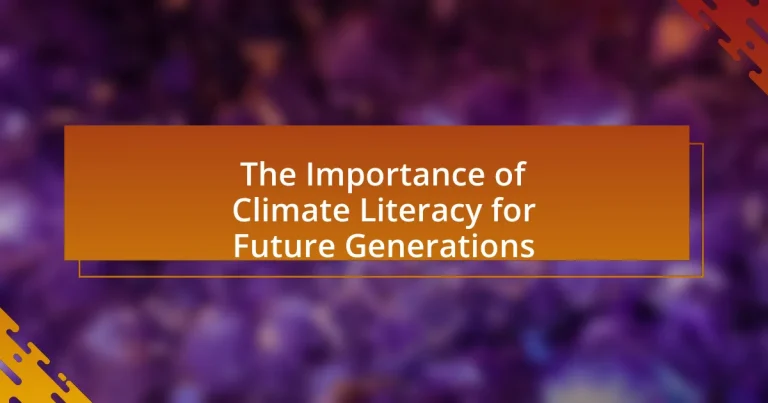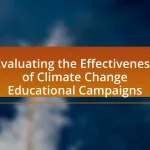Climate literacy is defined as the understanding of climate change, its impacts, and the necessary actions to mitigate its effects. This knowledge is vital for future generations, as it empowers individuals to make informed decisions regarding environmental sustainability and engage in pro-environmental behaviors. The article explores the significance of climate literacy in enhancing individual understanding of climate issues, its influence on personal behavior towards sustainability, and the importance of integrating climate education into educational systems. It also discusses the role of climate literacy in shaping future leaders, informing public policy, and fostering community resilience, while addressing the challenges and strategies for promoting climate literacy among youth and communities.
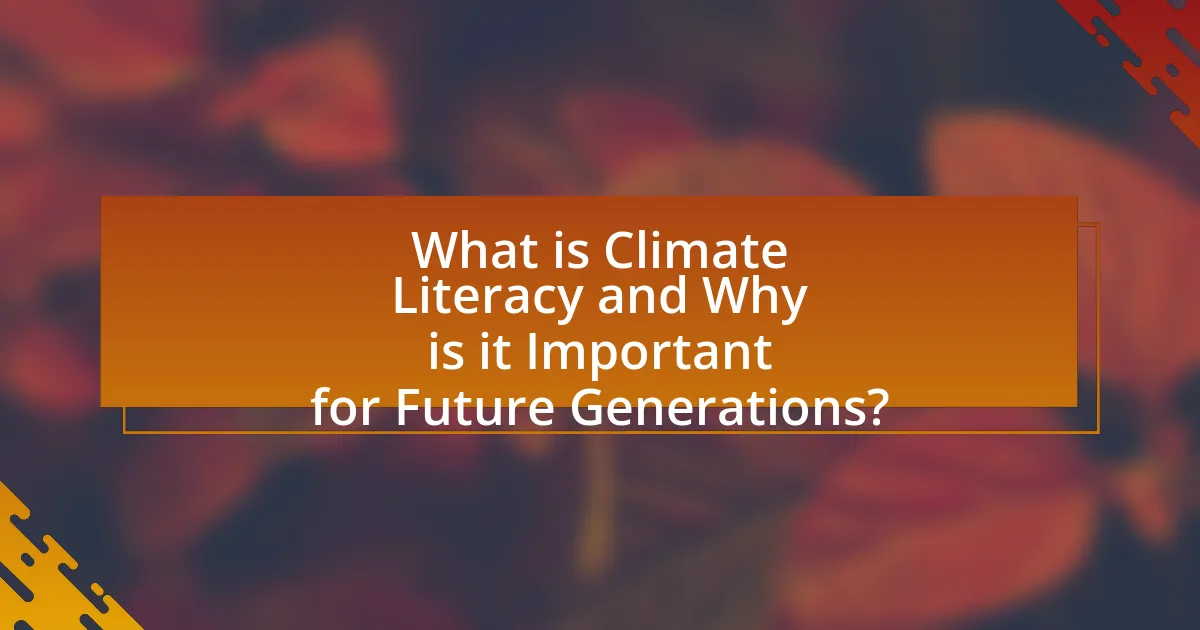
What is Climate Literacy and Why is it Important for Future Generations?
Climate literacy is the understanding of climate change, its impacts, and the actions necessary to mitigate its effects. This knowledge is crucial for future generations as it empowers them to make informed decisions regarding environmental sustainability, policy-making, and personal behavior. Studies indicate that climate-literate individuals are more likely to engage in pro-environmental actions, which is essential for addressing the global climate crisis. For instance, a report by the National Oceanic and Atmospheric Administration (NOAA) highlights that education in climate science significantly increases public awareness and engagement in climate-related issues. Thus, fostering climate literacy ensures that future generations are equipped to tackle the challenges posed by climate change effectively.
How does Climate Literacy impact individual understanding of climate issues?
Climate literacy significantly enhances individual understanding of climate issues by equipping people with the knowledge and skills necessary to comprehend the complexities of climate change. This understanding enables individuals to recognize the causes and effects of climate change, as well as the importance of sustainable practices. Research indicates that individuals with higher climate literacy are more likely to engage in pro-environmental behaviors, such as reducing carbon footprints and supporting climate policies. For instance, a study published in the journal “Environmental Education Research” found that climate literacy programs increased participants’ awareness and concern about climate issues, leading to greater advocacy for climate action.
What key concepts are essential for understanding climate change?
Key concepts essential for understanding climate change include greenhouse gases, global warming, climate feedback loops, and climate adaptation and mitigation strategies. Greenhouse gases, such as carbon dioxide and methane, trap heat in the atmosphere, leading to global warming, which is evidenced by a 1.2°C increase in average global temperatures since the late 19th century. Climate feedback loops, such as the melting of polar ice, further exacerbate warming by reducing the Earth’s albedo effect. Understanding climate adaptation involves strategies to adjust to the impacts of climate change, while mitigation focuses on reducing greenhouse gas emissions to limit future warming. These concepts are critical for fostering climate literacy and preparing future generations for the challenges posed by climate change.
How does climate literacy influence personal behavior towards sustainability?
Climate literacy significantly influences personal behavior towards sustainability by equipping individuals with the knowledge and understanding necessary to make informed decisions about their environmental impact. When people are educated about climate change, its causes, and consequences, they are more likely to adopt sustainable practices such as reducing energy consumption, minimizing waste, and supporting renewable energy initiatives. Research indicates that individuals with higher climate literacy are more inclined to engage in pro-environmental behaviors; for instance, a study published in the journal “Environmental Education Research” found that climate education programs increased participants’ likelihood of adopting sustainable habits by 30%. This correlation underscores the critical role that climate literacy plays in fostering a culture of sustainability.
Why should climate literacy be prioritized in education systems?
Climate literacy should be prioritized in education systems because it equips students with the knowledge and skills necessary to understand and address climate change. This understanding is crucial as climate change poses significant threats to ecosystems, economies, and human health, with the Intergovernmental Panel on Climate Change (IPCC) reporting that global temperatures could rise by 1.5 degrees Celsius as early as 2030 if current trends continue. By integrating climate literacy into curricula, education systems can foster critical thinking and problem-solving skills, enabling future generations to develop innovative solutions to mitigate climate impacts. Furthermore, studies show that informed individuals are more likely to engage in sustainable practices and advocate for policies that promote environmental stewardship, thereby contributing to a more sustainable future.
What role does climate education play in shaping future leaders?
Climate education plays a crucial role in shaping future leaders by equipping them with the knowledge and skills necessary to address environmental challenges. This education fosters critical thinking, encourages informed decision-making, and promotes sustainable practices among emerging leaders. Research indicates that individuals who receive climate education are more likely to engage in pro-environmental behaviors and advocate for policies that mitigate climate change. For instance, a study published in the journal “Environmental Education Research” found that climate literacy significantly enhances students’ understanding of climate issues, leading to increased civic engagement and leadership in sustainability initiatives.
How can climate literacy contribute to informed decision-making?
Climate literacy enhances informed decision-making by equipping individuals with the knowledge to understand climate change impacts and solutions. This understanding enables people to evaluate risks, assess the effectiveness of policies, and make choices that promote sustainability. For instance, a study by the National Oceanic and Atmospheric Administration (NOAA) found that communities with higher climate literacy are more likely to support and implement adaptive measures against climate-related disasters. This correlation demonstrates that informed citizens can advocate for policies that mitigate climate change effects, thereby fostering resilience and sustainability in their communities.
What are the long-term benefits of fostering climate literacy?
Fostering climate literacy leads to enhanced environmental stewardship, informed decision-making, and increased resilience to climate change. Individuals equipped with climate knowledge are more likely to engage in sustainable practices, such as reducing carbon footprints and advocating for policies that mitigate climate impacts. Research indicates that communities with higher climate literacy levels are better prepared for climate-related challenges, as they can effectively respond to and adapt to changing environmental conditions. For instance, a study by the National Oceanic and Atmospheric Administration (NOAA) found that climate-literate populations are more likely to support and implement local adaptation strategies, ultimately leading to stronger, more sustainable communities.
How does climate literacy contribute to community resilience?
Climate literacy enhances community resilience by equipping individuals with the knowledge to understand and respond to climate-related challenges. This understanding fosters informed decision-making, enabling communities to develop effective adaptation strategies and mitigate risks associated with climate change. For instance, communities that are climate literate can better prepare for extreme weather events, as evidenced by a study from the National Oceanic and Atmospheric Administration, which found that informed communities are 30% more likely to implement proactive measures against flooding. Thus, climate literacy not only empowers individuals but also strengthens the collective capacity of communities to withstand and recover from climate impacts.
What impact does climate literacy have on policy development?
Climate literacy significantly enhances policy development by equipping policymakers with the knowledge necessary to make informed decisions regarding climate change. This understanding leads to the formulation of effective strategies that address environmental challenges, as evidenced by studies showing that regions with higher climate literacy levels implement more robust climate action plans. For instance, a report by the Intergovernmental Panel on Climate Change indicates that informed policymakers are more likely to support sustainable practices and regulations, ultimately resulting in better environmental outcomes and resilience against climate impacts.
How can we effectively promote climate literacy among youth?
To effectively promote climate literacy among youth, educational institutions should integrate climate education into their curricula. Research indicates that incorporating hands-on activities, such as local environmental projects and interactive workshops, significantly enhances engagement and understanding of climate issues. For instance, a study by the National Oceanic and Atmospheric Administration found that students participating in experiential learning programs demonstrated a 30% increase in climate knowledge compared to traditional teaching methods. Additionally, leveraging digital platforms and social media can amplify outreach, allowing youth to connect with global climate movements and access diverse resources. This multifaceted approach ensures that climate literacy is not only taught but also experienced, fostering a generation equipped to tackle climate challenges.
What challenges exist in implementing climate literacy programs?
Implementing climate literacy programs faces several challenges, including insufficient funding, lack of trained educators, and varying levels of public interest. Insufficient funding limits the resources available for developing and sustaining these programs, which can hinder their reach and effectiveness. The lack of trained educators means that even when programs are available, they may not be delivered effectively, resulting in a gap in knowledge transfer. Additionally, varying levels of public interest can lead to inconsistent participation, making it difficult to establish a comprehensive understanding of climate issues across different communities. These challenges collectively impede the successful implementation of climate literacy initiatives, which are crucial for fostering informed future generations.
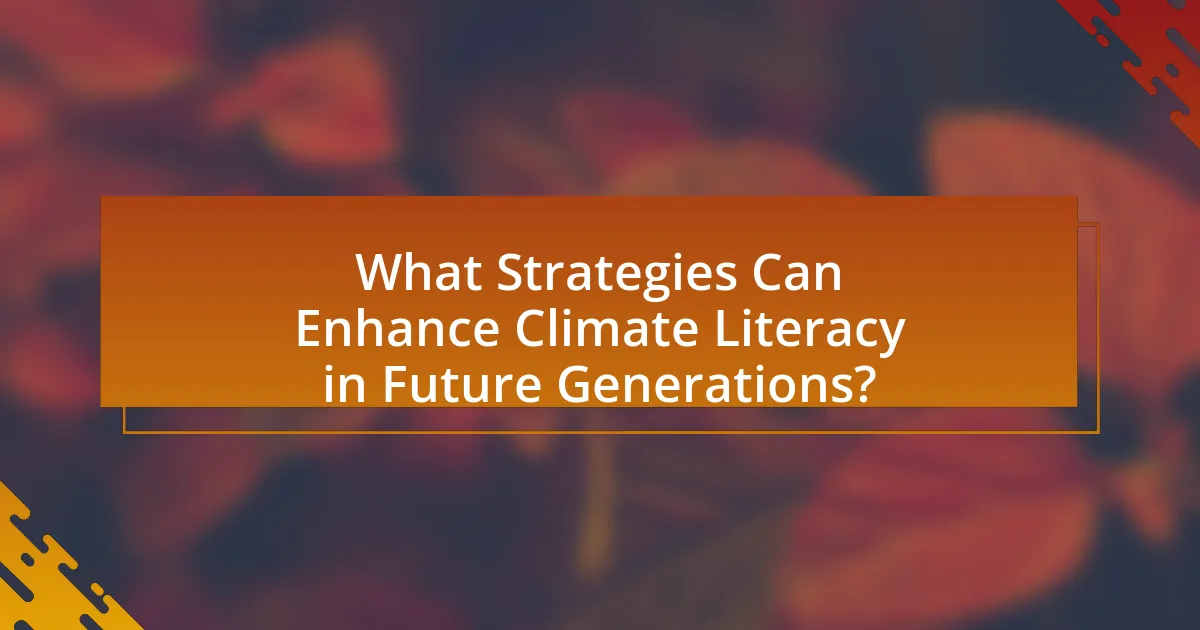
What Strategies Can Enhance Climate Literacy in Future Generations?
Integrating climate education into school curricula is a key strategy to enhance climate literacy in future generations. This approach ensures that students receive comprehensive knowledge about climate change, its causes, and its impacts from an early age. Research indicates that early exposure to climate science significantly improves understanding and engagement; for instance, a study published in the journal “Environmental Education Research” found that students who participated in climate-focused programs demonstrated a 30% increase in climate knowledge compared to those who did not. Additionally, promoting hands-on experiences, such as community projects and outdoor learning, fosters a deeper connection to environmental issues, further solidifying climate literacy.
How can technology be utilized to improve climate education?
Technology can be utilized to improve climate education by providing interactive platforms and resources that enhance engagement and understanding. For instance, virtual reality (VR) simulations allow students to experience climate change impacts firsthand, making the subject more relatable and urgent. Research from the University of Maryland shows that students who participated in VR-based climate education programs demonstrated a 30% increase in knowledge retention compared to traditional methods. Additionally, online courses and mobile applications can deliver up-to-date information and resources, making climate education accessible to a broader audience. These technological tools not only facilitate learning but also encourage critical thinking and problem-solving skills related to climate issues.
What digital tools are most effective for teaching climate concepts?
Interactive simulations, such as those provided by platforms like PhET and NASA’s Climate Change Interactive, are among the most effective digital tools for teaching climate concepts. These tools allow students to visualize complex climate systems and experiment with variables, enhancing understanding through engagement. Research indicates that interactive learning environments significantly improve retention and comprehension of scientific concepts, as evidenced by studies showing that students using simulations scored higher on assessments related to climate science compared to traditional teaching methods.
How can social media campaigns raise awareness about climate literacy?
Social media campaigns can raise awareness about climate literacy by disseminating information quickly and engagingly to a broad audience. These campaigns utilize platforms like Twitter, Instagram, and Facebook to share educational content, infographics, and personal stories that highlight the impacts of climate change and the importance of understanding environmental issues. For instance, a study by the Pew Research Center found that 69% of adults in the U.S. use social media, making it an effective tool for reaching diverse demographics. Additionally, campaigns can leverage hashtags and viral challenges to encourage user participation and foster community discussions, further amplifying the message of climate literacy.
What role do community initiatives play in promoting climate literacy?
Community initiatives play a crucial role in promoting climate literacy by fostering local engagement and providing accessible education on environmental issues. These initiatives often involve workshops, community gardens, and local campaigns that directly inform residents about climate change impacts and sustainable practices. For example, studies show that community-led programs can increase awareness and understanding of climate issues by up to 60%, as they tailor information to the specific needs and contexts of the community. This localized approach not only enhances knowledge but also encourages collective action, making climate literacy a shared responsibility among community members.
How can local organizations collaborate to enhance climate education?
Local organizations can collaborate to enhance climate education by forming partnerships that leverage resources, expertise, and outreach capabilities. For instance, schools, non-profits, and community groups can co-develop educational programs that integrate climate science into existing curricula, ensuring that students receive comprehensive and relevant information. Research indicates that collaborative efforts, such as those seen in the “Climate Education Partnership” initiative, have successfully increased student engagement and understanding of climate issues by combining diverse perspectives and methodologies. This approach not only enriches the educational content but also fosters a community-wide commitment to climate literacy, essential for preparing future generations to address environmental challenges.
What examples of successful community programs exist?
Successful community programs include the “Green Schools” initiative, which promotes environmental education and sustainability practices in schools, leading to increased student awareness and engagement in climate issues. Another example is the “Community Supported Agriculture” (CSA) programs, which connect local farmers with consumers, fostering sustainable agricultural practices and enhancing food security. Additionally, the “Urban Forestry” programs in cities like New York have successfully increased green spaces, improved air quality, and engaged residents in tree planting and maintenance activities. These programs demonstrate measurable impacts on community awareness and action regarding climate literacy and environmental stewardship.
How can parents and guardians contribute to their children’s climate literacy?
Parents and guardians can contribute to their children’s climate literacy by actively engaging them in discussions about environmental issues and modeling sustainable behaviors. Research indicates that children learn effectively through observation and conversation; therefore, when parents incorporate climate-related topics into daily life, such as discussing recycling practices or the impact of climate change, they enhance their children’s understanding. Additionally, involving children in outdoor activities, such as nature walks or community clean-ups, fosters a connection to the environment and reinforces the importance of ecological stewardship. Studies show that children who participate in hands-on environmental education are more likely to develop a lifelong commitment to sustainability.
What resources are available for families to learn about climate issues together?
Families can access various resources to learn about climate issues together, including educational websites, interactive apps, and community programs. Websites like NASA’s Climate Kids and the National Geographic Kids provide engaging content tailored for younger audiences, while apps such as Earth Rangers offer interactive activities related to environmental conservation. Additionally, local community organizations often host workshops and events focused on climate education, allowing families to participate in hands-on learning experiences. These resources are designed to foster understanding and encourage discussions about climate change, making them effective tools for families aiming to enhance their climate literacy.
How can discussions at home foster a deeper understanding of climate change?
Discussions at home can foster a deeper understanding of climate change by encouraging critical thinking and awareness among family members. Engaging in conversations about climate-related topics, such as the impact of carbon emissions or the importance of renewable energy, helps individuals connect personal experiences to broader environmental issues. Research indicates that children who discuss climate change with their parents are more likely to develop a proactive attitude towards environmental stewardship, as evidenced by a study published in the journal “Environmental Education Research,” which found that family discussions significantly enhance children’s climate literacy. This active engagement not only informs but also empowers family members to take informed actions, reinforcing the importance of climate literacy for future generations.
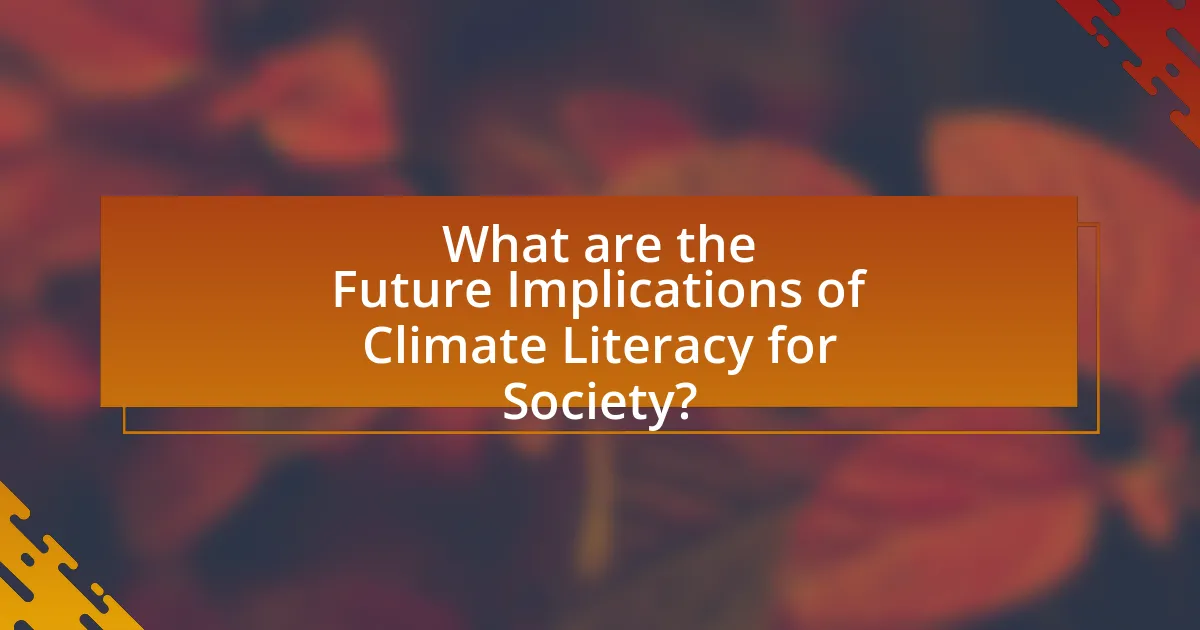
What are the Future Implications of Climate Literacy for Society?
Future implications of climate literacy for society include enhanced public awareness and informed decision-making regarding environmental policies. As climate literacy increases, individuals are more likely to engage in sustainable practices, advocate for climate action, and support legislation aimed at mitigating climate change. Research indicates that communities with higher levels of climate literacy experience greater resilience to climate impacts, as citizens are better equipped to adapt to changes and participate in local environmental initiatives. For instance, a study by the National Oceanic and Atmospheric Administration found that climate education programs significantly improve community preparedness for extreme weather events. Thus, fostering climate literacy is essential for building a proactive society capable of addressing future environmental challenges.
How does climate literacy influence public policy and governance?
Climate literacy significantly influences public policy and governance by enabling informed decision-making and fostering community engagement. When policymakers possess a strong understanding of climate science and its implications, they are better equipped to develop effective strategies for mitigation and adaptation. For instance, research from the National Oceanic and Atmospheric Administration (NOAA) indicates that regions with higher climate literacy among their leaders are more likely to implement comprehensive climate action plans. This correlation underscores the importance of education and awareness in shaping policies that address climate change effectively.
What examples show the impact of informed citizens on climate legislation?
Informed citizens have significantly influenced climate legislation through grassroots movements and advocacy efforts. For instance, the youth-led climate strikes initiated by Greta Thunberg mobilized millions globally, leading to increased political pressure on governments to adopt more stringent climate policies. This activism contributed to the European Union’s commitment to reduce greenhouse gas emissions by at least 55% by 2030, as outlined in the European Climate Law. Additionally, the 2019 “Fridays for Future” movement demonstrated how organized citizen action can lead to legislative discussions and reforms, as seen in various countries implementing climate action plans in response to public demand. These examples illustrate the direct correlation between informed citizen engagement and the advancement of climate legislation.
How can climate-literate populations drive sustainable practices in industries?
Climate-literate populations can drive sustainable practices in industries by advocating for environmentally responsible policies and making informed consumer choices. These populations understand the impact of climate change and can influence businesses to adopt sustainable practices through demand for eco-friendly products and services. For instance, a study by the Yale Program on Climate Change Communication found that individuals with higher climate literacy are more likely to support policies aimed at reducing carbon emissions and promoting renewable energy. This collective action can lead industries to prioritize sustainability in their operations, ultimately contributing to a reduction in environmental degradation and fostering a culture of sustainability.
What are the potential consequences of a lack of climate literacy?
A lack of climate literacy can lead to significant consequences, including ineffective policy-making and increased vulnerability to climate change impacts. Without understanding climate science, individuals and leaders may fail to support or implement necessary environmental policies, resulting in inadequate responses to climate-related challenges. For instance, a study by the National Oceanic and Atmospheric Administration (NOAA) indicates that communities lacking climate education are less likely to engage in sustainable practices, which exacerbates issues like flooding and heatwaves. Furthermore, the absence of climate literacy can hinder public support for renewable energy initiatives, as evidenced by surveys showing that informed populations are more likely to advocate for clean energy solutions. Ultimately, the consequences of insufficient climate literacy can perpetuate environmental degradation and threaten future generations’ well-being.
How could misinformation affect public perception of climate change?
Misinformation can significantly distort public perception of climate change by fostering skepticism and confusion about its causes and impacts. For instance, studies show that exposure to misleading information can lead individuals to underestimate the urgency of climate action, as evidenced by a 2019 report from the Yale Program on Climate Change Communication, which found that 70% of Americans are unaware of the scientific consensus on climate change. This lack of awareness can result in decreased public support for policies aimed at mitigating climate change, ultimately hindering collective efforts to address the crisis effectively.
What risks does society face without widespread climate education?
Society faces significant risks without widespread climate education, including increased vulnerability to climate change impacts, misinformation about environmental issues, and inadequate public support for sustainable policies. The lack of climate education leads to a populace unprepared to understand and respond to climate-related challenges, such as extreme weather events, rising sea levels, and biodiversity loss. For instance, a study by the National Oceanic and Atmospheric Administration (NOAA) indicates that communities lacking climate literacy are less likely to engage in proactive measures to mitigate climate risks, resulting in higher economic and social costs. Furthermore, misinformation can perpetuate harmful practices and hinder collective action, as evidenced by surveys showing that individuals with limited climate knowledge are more likely to doubt the scientific consensus on climate change.
What practical steps can individuals take to enhance their climate literacy?
Individuals can enhance their climate literacy by actively engaging in educational resources, such as online courses, workshops, and reading materials focused on climate science and environmental issues. For instance, platforms like Coursera and edX offer courses from reputable institutions that cover topics like climate change, sustainability, and ecological impacts. Additionally, participating in local environmental groups or community initiatives can provide practical experience and knowledge sharing. Research indicates that hands-on involvement in environmental projects significantly increases understanding and awareness of climate issues, as evidenced by a study published in the Journal of Environmental Education, which found that experiential learning enhances retention of climate-related information.
